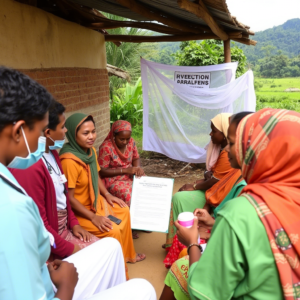Malaria, a disease as old as human civilization, continues to plague millions worldwide. Despite advancements in medicine and public health, it remains a leading cause of death in tropical and subtropical regions.
Read Also: Long Covid
Transmitted through the bite of an infected mosquito, malaria disrupts lives, strains healthcare systems, and perpetuates cycles of poverty. This article explores the causes, symptoms, prevention strategies, and global efforts to combat this relentless disease—and why eradication remains an uphill battle.
What Causes Malaria?
The Parasite and the Vector
Malaria is caused by Plasmodium parasites, microscopic organisms transmitted through the bites of female Anopheles mosquitoes. Five species infect humans:
- Plasmodium falciparum: The deadliest, responsible for most malaria-related deaths.
- Plasmodium vivax: Can lie dormant in the liver, causing relapses months or years later.
- Plasmodium ovule, Plasmodium malariae, and Plasmodium knowledge: Less common but still dangerous.
When an infected mosquito bites, it injects parasites into the bloodstream. These travel to the liver, multiply, and re-enter the blood, destroying red blood cells and triggering symptoms.
High-Risk Regions
Malaria thrives in warm, humid climates. Sub-Saharan Africa bears the heaviest burden, accounting for 95% of global cases and deaths. Other hotspots include South Asia, Latin America, and parts of Oceania.
Symptoms and Diagnosis
Recognizing the Signs
Symptoms typically appear 10–15 days after a bite and include:
- High fever and chills
- Headaches and muscle pain
- Fatigue, nausea, and vomiting
- Anemia and jaundice (in severe cases).
Plasmodium falciparum infections can escalate rapidly, causing seizures, kidney failure, or coma.
Diagnostic Methods
Early diagnosis is critical. Methods include:
- Rapid Diagnostic Tests (RDTs): Detect parasite proteins in blood.
- Microscopy: Gold standard for identifying species and parasite density.
- PCR Tests: Used for research or confirming complex cases.
Prevention Strategies
Insecticide-Treated Nets (ITNs)
Sleeping under ITNs reduces mosquito contact. The World Health Organization (WHO) estimates ITNs have prevented 68% of malaria cases in Africa since 2000.
Indoor Residual Spraying (IRS)
Spraying homes with insecticides kills mosquitoes on contact. However, resistance to common chemicals like pyrethroids is rising.
Antimalarial Medications
Travelers to endemic areas often take prophylactic drugs (e.g., doxycycline or atovaquone-proguanil). Pregnant women in high-risk regions may receive intermittent preventive treatment (IPT).
Community Education and Innovation
Awareness campaigns promote early treatment, while novel tools like genetically modified mosquitoes and climate-based forecasting show promise.
Treatment Options
First-Line Therapies
Artemisinin-based Combination Therapies (ACTs) are the standard for uncomplicated malaria. They combine fast-acting artemisinin with a slower partner drug to prevent resistance.
Severe Malaria Management
Severe cases require hospitalization and intravenous artesunate, which reduces mortality by 22% compared to quinine.
The Challenge of Drug Resistance
Parasite resistance to artemisinin has emerged in Southeast Asia, threatening global progress. Researchers are racing to develop new drugs, such as tafenoquine for P. vivax.
Global Efforts to Combat Malaria
The Roll Back Malaria Partnership
Launched in 1998, this coalition of governments, NGOs, and companies aims to cut malaria deaths by 90% by 2030. Key achievements include distributing 2.5 billion ITNs globally.
Vaccine Breakthroughs
In 2021, the WHO endorsed RTS,S/AS01 (Mosquirix), the first malaria vaccine. Though efficacy is modest (30–40%), it’s a game-changer for children in high-risk areas. The newer R21/Matrix-M vaccine, approved in 2023, shows 75% efficacy in trials.
Funding and Equity
The Global Fund to Fight AIDS, Tuberculosis, and Malaria has invested over $15 billion in malaria programs since 2002. Yet, funding gaps persist—especially in conflict zones.
Challenges in Eradicating Malaria
Climate Change and Urbanization
Warmer temperatures expand mosquito habitats, while urbanization creates breeding sites in stagnant water.
Socioeconomic Barriers
Poverty limits access to nets and healthcare. Cultural beliefs may delay treatment-seeking, worsening outcomes.
Political Instability
Conflict disrupts supply chains and displaces populations, as seen in Yemen and South Sudan.
Frequently Asked Questions (FAQ)
1. Can malaria spread directly between people?
No—it requires a mosquito vector. Rare exceptions include blood transfusions or mother-to-child transmission during pregnancy.
2. Is there a vaccine for adults?
Current vaccines target children in high-risk areas, but research is ongoing for broader protection.
3. Can I get malaria more than once?
Yes—recovery doesn’t guarantee immunity. Reinfections are common.
4. Why isn’t malaria prevalent in the U.S.?
Improved sanitation, mosquito control, and healthcare systems eliminated local transmission by the 1950s.
5. Are all mosquitoes dangerous?
Only female Anopheles mosquitoes transmit malaria. Most bites cause itching, not disease.
6. How can I help fight malaria?
Donate to organizations like Nothing But Nets or advocate for global health funding.
Conclusion
Malaria is more than a health crisis—it’s a barrier to education, economic stability, and equality. While progress has been made, complacency is not an option. Innovations like vaccines and next-generation nets offer hope, but sustained investment and political will are essential. By supporting research, advocating for equity, and spreading awareness, we can inch closer to a malaria-free world.
As the saying goes, “It takes a village to defeat a disease.” Let’s be that village.

